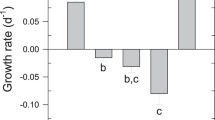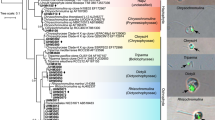Abstract
RECENT researches have stimulated interest in marine nannoplankton. Hydrographical evidence suggested that the bulk of organic production off Plymouth might have been due to autotrophic flagellates rather than to diatoms1. The pigment-extraction method indicated that during frequent sampling more than 90 per cent of the total mass of phytoplankton passed through the meshes (40 µ × 50 µ) of a fine net, and that on the only two occasions for which results are given, about 40 per cent passed through Whatman No. 2 filter paper2. The small size of ultraplankton organisms (about 5 µ; Thorson3 gives references to the authors of this unfamiliar but convenient term) does not prevent their use as food by important members of the zooplankton, for a pure culture of a flagellate less than 2 µ in size has supported growth in Calanus4. Flagellates of about 10 µ or less form the essential food of oyster larvæ5–7, and hence probably of most of the planktotrophic larvæ which are met with in the development of more than 70 per cent of all benthic invertebrates8.
This is a preview of subscription content, access via your institution
Access options
Subscribe to this journal
Receive 51 print issues and online access
$199.00 per year
only $3.90 per issue
Buy this article
- Purchase on Springer Link
- Instant access to full article PDF
Prices may be subject to local taxes which are calculated during checkout
Similar content being viewed by others
References
Atkins, W. R. G., Nature, 156, 446 (1945).
Harvey, H. W., J. Mar. Biol. Assoc., 29, 97 (1950).
Thorson, G., Medd. Komm. Danmarks Fisk. Havunde., Ser. Plankton, 4, No. 1 (1946).
Raymont, J. E. G., and Gross, F., Proc. Roy. Soc. Edin., B, 61, 267 (1942).
Cole, H. A., Fish. Invest., Series II, 15, No. 4 (1936).
Cole, H. A., Fish. Invest., Series II, 16, No. 4 (1939).
Bruce, J. R., Knight, M., and Parke, M. W., J. Mar. Biol. Assoc., 24, 337 (1940).
Thorson, B., Biol. Rev., 25, 1 (1950).
Parke, Mary W., J. Mar. Biol. Assoc., 28, 255 (1949).
Butcher, R. W., J. Mar. Biol. Assoc. (in the press).
Gross, F., Raymont, J. E. G., Nutman, S. R., and Gauld, D. T., Nature, 158, 187 (1946).
Cole, H. A., and Knight-Jones, E. W., Nature, 164, 694 (1949).
Ministry of Health. Rep. Pub. Health and Med. Subjects, 71 (revised edition, 1940).
Swaroop, S., Ind. J. Med. Res., 26, 353 (1938).
Gross, F., J. Mar. Biol. Assoc., 21, 753 (1937).
Lowndes, A. G., Nature, 155, 579 and 795 (1945).
Gross, F., and Koczy, F. F., Göteborgs Kungl. Vetenskaps-och Vitterhets-samhälles Handl. Sjätte Följden, Ser. B, 5, 3 (1946).
Author information
Authors and Affiliations
Rights and permissions
About this article
Cite this article
KNIGHT-JONES, E., WALNE, P. Chromulina pusilla Butcher, a Dominant Member of the Ultraplankton. Nature 167, 445–446 (1951). https://doi.org/10.1038/167445a0
Issue Date:
DOI: https://doi.org/10.1038/167445a0
This article is cited by
Comments
By submitting a comment you agree to abide by our Terms and Community Guidelines. If you find something abusive or that does not comply with our terms or guidelines please flag it as inappropriate.



